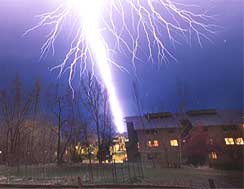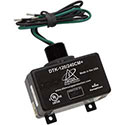 Surge Protective Devices (SPD’s) are now subject to new standards. UL 1449 3rd Edition was published in September 2006 with compliance required by September 2009. Some differences in terminology from transient voltage surge suppressors (TVSS) to SPD’s and some more requirements in labeling and marking the discharge current are in effect. The main difference is that the surge units must be able to handle a higher and more repetitive over voltage/overcurrent without being damaged. Learn More! Surge Protective Devices (SPD’s) are now subject to new standards. UL 1449 3rd Edition was published in September 2006 with compliance required by September 2009. Some differences in terminology from transient voltage surge suppressors (TVSS) to SPD’s and some more requirements in labeling and marking the discharge current are in effect. The main difference is that the surge units must be able to handle a higher and more repetitive over voltage/overcurrent without being damaged. Learn More!
Most surge damage does not occur in one single, arc producing incident. Instead, the constant bombardment of these short-duration impulses on electronic components causes them to wear prematurely and fail. All of your computers should be protected by a surge suppressor. They are filled with voltage-sensitive components that a power surge could damage very easily. At the very least, this damage will shorten the life of your computer, and it could very easily wipe out all of your saved data or destroy your system. Computers are very expensive items, and the data they hold is often irreplaceable, so it's only good economic sense to invest in a quality surge protector.
A power surge, or transient voltage, is an increase in voltage significantly above the designated level in a flow of electricity. In normal household and office wiring in the United States, the standard voltage is 120 volts. If the voltage rises above 120 volts, a problem exists, and a surge protector helps to prevent that problem from destroying your computer. Even if increased voltage doesn't immediately break your machine, it may put extra strain on the components, wearing them down over time.
 A standard surge protector passes the electrical current along from the outlet to a number of electrical and electronic devices plugged into the power strip. If the voltage from the outlet surges or spikes -- rises above the accepted level -- the surge protector diverts the extra electricity into the outlet's grounding wire. A standard surge protector passes the electrical current along from the outlet to a number of electrical and electronic devices plugged into the power strip. If the voltage from the outlet surges or spikes -- rises above the accepted level -- the surge protector diverts the extra electricity into the outlet's grounding wire.
Whole House Surge Protectors
A popular series called Holmes on Homes recommends Panel Mount Surge Surpressors, commonly referred to as Whole House Surge Protectors like the SYC-120/240TC from Sycom, which are used to protect household items such as refrigerators, freezers, washers, dryers, dishwashers, trash compactors, air conditioners, garbage disposals, and electric stoves. Because most of the surges from your home and office are from these devices turning on/off, surge supressors like these are cost effective. They are the first stage, heavy-duty filter for power line disturbances. These units are installed at the electrical service entry of the building by a licensed electrician and often provide a warranty for the appliances connected. While panel mount surge suppression is the first stage of protection, plug-in surge units and Uninterruptable Power Supplies (UPS) are recommend as a second and third stage of surge protection for electronic components.
Usually a varistor, also known as an MOV, connects the power line to the ground. When the voltage spikes, these varistors allow the current to run to the ground and dissipate the surge. When current returns to normal, the varistors have higher resistance that prevent normal current from traveling to the ground. Another method uses a gas tube in a similar parallel circuit to perform the same job as the varistor.
Some surge products use a series circuit design instead. Basically, these suppressors detect the higher voltage, store the extra energy in a series of capacitors, and release it gradually to the neutral line when the current returns to its normal state. The idea is to prevent the electricity from traveling to the ground line and possibly disrupting the building's electrical system.
Newer surge suppression equipment similar to the series circuit design is being designed to also protect the ground wire from bi-directional transient current. Circuits are added to make transient current unidirectional, passing any surplus energy back down the neutral wire and into the transformer or back to the distribution panel where it is dissipated. This is similar to a one-way valve in a water pipe that prevents water from flowing backwards in a pipe.
Many surge suppressors combine technologies, and better surge suppressors arrange them in multiple stages to prolong life and improve response time. They utilize a lattice of MOVs, avalanche diodes, reactive circuits, and capacitors that eliminate line noise.
Surge suppressors can’t be completely relied upon during lightning storms because of the tremendous surge in current. The safest solution would be to unplug the device. Lightning is not the most common cause for surges, though. Surprisingly, high-power electrical devices, such as elevators, air conditioners and refrigerators are usually the culprit for surges because of the demand placed on the system turning on and off components like compressors and motors in these appliances.
 An ordinary UPS WILL give you a high level of protection, but you should still use a surge protector. A UPS will stop most surges from reaching your computer, but it will probably suffer severe damage itself. It's a good idea to use a basic surge protector, if just to save your UPS. An ordinary UPS WILL give you a high level of protection, but you should still use a surge protector. A UPS will stop most surges from reaching your computer, but it will probably suffer severe damage itself. It's a good idea to use a basic surge protector, if just to save your UPS.
Sources:
http://computer.howstuffworks.com/surge-protector.htm
http://en.wikipedia.org/wiki/Surge_protector
http://www.extremetech.com/article2/0,1697,1155241,00.asp
http://www.sycomsurge.com/
http://www.ditekcorp.com/
|